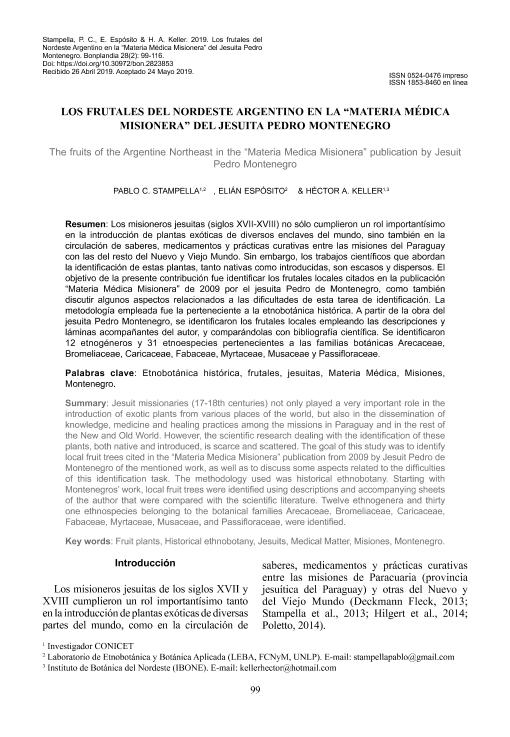Mostrar el registro sencillo del ítem
dc.contributor.author
Stampella, Pablo César

dc.contributor.author
Espósito Sandoval, Elián Maximiliano

dc.contributor.author
Keller, Hector Alejandro

dc.date.available
2020-12-15T13:37:08Z
dc.date.issued
2019-07
dc.identifier.citation
Stampella, Pablo César; Espósito Sandoval, Elián Maximiliano; Keller, Hector Alejandro; Los frutales del nordeste argentino en la “materia médica misionera” del Jesuita Pedro Montenegro; Instituto de Botanica del Nordeste; Bonplandia; 28; 2; 7-2019; 99-116
dc.identifier.issn
0524-0476
dc.identifier.uri
http://hdl.handle.net/11336/120427
dc.description.abstract
Los misioneros jesuitas (siglos XVII-XVIII) no sólo cumplieron un rol importantísimo en la introducción de plantas exóticas de diversos enclaves del mundo, sino también en la circulación de saberes, medicamentos y prácticas curativas entre las misiones del Paraguay con las del resto del Nuevo y Viejo Mundo. Sin embargo, los trabajos científicos que abordan la identificación de estas plantas, tanto nativas como introducidas, son escasos y dispersos. Elobjetivo de la presente contribución fue identificar los frutales locales citados en la publicación ?Materia Médica Misionera? de 2009 por el jesuita Pedro de Montenegro, como también discutir algunos aspectos relacionados a las dificultades de esta tarea de identificación. La metodología empleada fue la perteneciente a la etnobotánica histórica. A partir de la obra del jesuita Pedro Montenegro, se identificaron los frutales locales empleando las descripciones yláminas acompañantes del autor, y comparándolas con bibliografía científica. Se identificaron 12 etnogéneros y 31 etnoespecies pertenecientes a las familias botánicas Arecaceae, Bromeliaceae, Caricaceae, Fabaceae, Myrtaceae, Musaceae y Passifloraceae.
dc.description.abstract
Jesuit missionaries (17-18th centuries) not only played a very important role in the introduction of exotic plants from various places of the world, but also in the dissemination of knowledge, medicine and healing practices among the missions in Paraguay and in the rest of the New and Old World. However, the scientific research dealing with the identification of these plants, both native and introduced, is scarce and scattered. The goal of this study was to identify local fruit trees cited in the “Materia Medica Misionera” publication from 2009 by Jesuit Pedro de Montenegro of the mentioned work, as well as to discuss some aspects related to the difficulties of this identification task. The methodology used was historical ethnobotany. Starting with Montenegros’ work, local fruit trees were identified using descriptions and accompanying sheets of the author that were compared with the scientific literature. Twelve ethnogenera and thirty one ethnospecies belonging to the botanical families Arecaceae, Bromeliaceae, Caricaceae, Fabaceae, Myrtaceae, Musaceae, and Passifloraceae, were identified.
dc.format
application/pdf
dc.language.iso
spa
dc.publisher
Instituto de Botanica del Nordeste
dc.rights
info:eu-repo/semantics/openAccess
dc.rights.uri
https://creativecommons.org/licenses/by/2.5/ar/
dc.subject
FRUIT PLANTS
dc.subject
HISTORICAL ETHNOBOTANY
dc.subject
JESUITS
dc.subject
MEDICAL MATTER
dc.subject
MISIONES
dc.subject
MONTENEGRO
dc.subject.classification
Ciencias de las Plantas, Botánica

dc.subject.classification
Ciencias Biológicas

dc.subject.classification
CIENCIAS NATURALES Y EXACTAS

dc.subject.classification
Antropología, Etnología

dc.subject.classification
Sociología

dc.subject.classification
CIENCIAS SOCIALES

dc.title
Los frutales del nordeste argentino en la “materia médica misionera” del Jesuita Pedro Montenegro
dc.title
The fruits of the argentine northeast in the “materia medica misionera” publication by Jesuit Pedro Montenegro
dc.type
info:eu-repo/semantics/article
dc.type
info:ar-repo/semantics/artículo
dc.type
info:eu-repo/semantics/publishedVersion
dc.date.updated
2020-11-18T17:03:17Z
dc.identifier.eissn
1853-8460
dc.journal.volume
28
dc.journal.number
2
dc.journal.pagination
99-116
dc.journal.pais
Argentina

dc.journal.ciudad
Corrientes
dc.description.fil
Fil: Stampella, Pablo César. Consejo Nacional de Investigaciones Científicas y Técnicas; Argentina. Universidad Nacional de La Plata. Facultad de Ciencias Naturales y Museo. Laboratorio de Etnobotánica y Botánica Aplicada; Argentina
dc.description.fil
Fil: Espósito Sandoval, Elián Maximiliano. Universidad Nacional de La Plata. Facultad de Ciencias Naturales y Museo. Laboratorio de Etnobotánica y Botánica Aplicada; Argentina
dc.description.fil
Fil: Keller, Hector Alejandro. Consejo Nacional de Investigaciones Científicas y Técnicas. Centro Científico Tecnológico Conicet - Nordeste. Instituto de Botánica del Nordeste. Universidad Nacional del Nordeste. Facultad de Ciencias Agrarias. Instituto de Botánica del Nordeste; Argentina
dc.journal.title
Bonplandia
dc.relation.alternativeid
info:eu-repo/semantics/altIdentifier/url/https://revistas.unne.edu.ar/index.php/bon/article/view/3853
dc.relation.alternativeid
info:eu-repo/semantics/altIdentifier/doi/http://dx.doi.org/10.30972/bon.2823853
Archivos asociados
